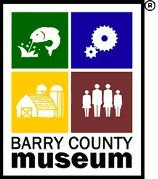Rockhouse Cave
Rock House Cave by Larry Tyler From Back to Barry (1989) |
Rockhouse Cave is the oldest continuing tourist attraction in Barry County and exists today as a link to a most colorful past. At ¼ mile in length, it is also one of the most extensive caverns to be found in the Table Rock area and is maintained as a free private-owned attraction especially suited for the education of youngsters on field trips or outings. Curator Larry Tyler will act as tour guide or give talks on the cave and its history to groups, on request. It is a Rock House tradition that people are free to come and go at leisure to the cave, observing the basic rules of safety and preservation, and at their own risk, to enjoy this local natural wonder as their grandparents and great grandparents did before them. This tradition continues today, adding to the serenity of the atmosphere and the relaxation of those who come to enjoy the cool air, clean water and mossy cliffs of the cafe mouth. No alcohol is allowed. |
 |
In 1938, the Rockhouse Cave farm was owned by Sig and Carrie Reno, who maintained the farm and its lovely state, planting many beautiful shrubs and flower bulbs which still beautify the place today. The great weeping willow tree which towers over the cave entrance was planted by Barbara Reno in 1945. For 34 years, until 1972, the farm was known as the Reno place, which offered the traditional Rockhouse hospitality to all visitors to the cave. |
 |
| The two traditional legends concerning Rockhouse Cave involved the story of the Spanish gold buried there (see: Caves of Missouri), and that there used to be a "bottomless pit" in which folks would toss rocks and "never hear them hit." The gold legend is somewhat supported by the existence of Spanish writing, the words "Aqui Es" ("Here it is") and an arrow on the wall of a small, almost never-visited cave near Rockhouse Cave, called "Spanish Cave." Sig Reno, it is said, once threw something down into the "bottomless pit" and "it came out at Roaring River," proving the subterranean connection between the two. Old-timers also say there used to be another, and larger, cavern passage which is no longer accessible, which led to an underground lake via a passage "large enough in some rooms to fit a house." One person reported catching blind fish in the lake and letting down "100 feet of line.” The Spanish gold legend is also supported by the map owned by William G. Carlin who appeared at the cave one day in 1930. Bill Bryant told that he helped Carlin find a stone with an X on it, marking the cave as the site of the buried Spanish gold. Thereafter, Carlin took out a contract with John England giving him half of "all gold, silver, lead, copper, and all other minerals or treasures that may be discovered ... " (Sept. 2, 1930). Carlin, however, never returned to mine the cave and his map remains a mystery. In 1972, shortly after the Renos sold to Thompson, someone dynamited the cave looking for the gold. The bottomless pit was blocked, and the "lost passage" was also apparently sealed off at that time. Old-timers entering the cave today remark that much fallen slabs and rocks didn't used to be there. Stella Nafus recalled coming to Rockhouse Cave in a horse and buggy in the early 1900's while courting. The earliest graffiti in the cave is from 1889, the names, date and birthdates of 17 year old Howard and McGraw boys. The name of Sarah Wilder is carved by the mouth, dating from around 1883-1903. One rock wall, called "daterock" holds the names of visitors for one hundred years. It is clear that Rockhouse Cave has been visited continuously since around 1860, and it remains an attraction enjoyed by many today, those who like to "go caving," and those who just wish to "look around." Rockhouse Cave is a living link to a most colorful past, a heritage to be preserved, and Barry County's oldest continuing natural attraction. |


